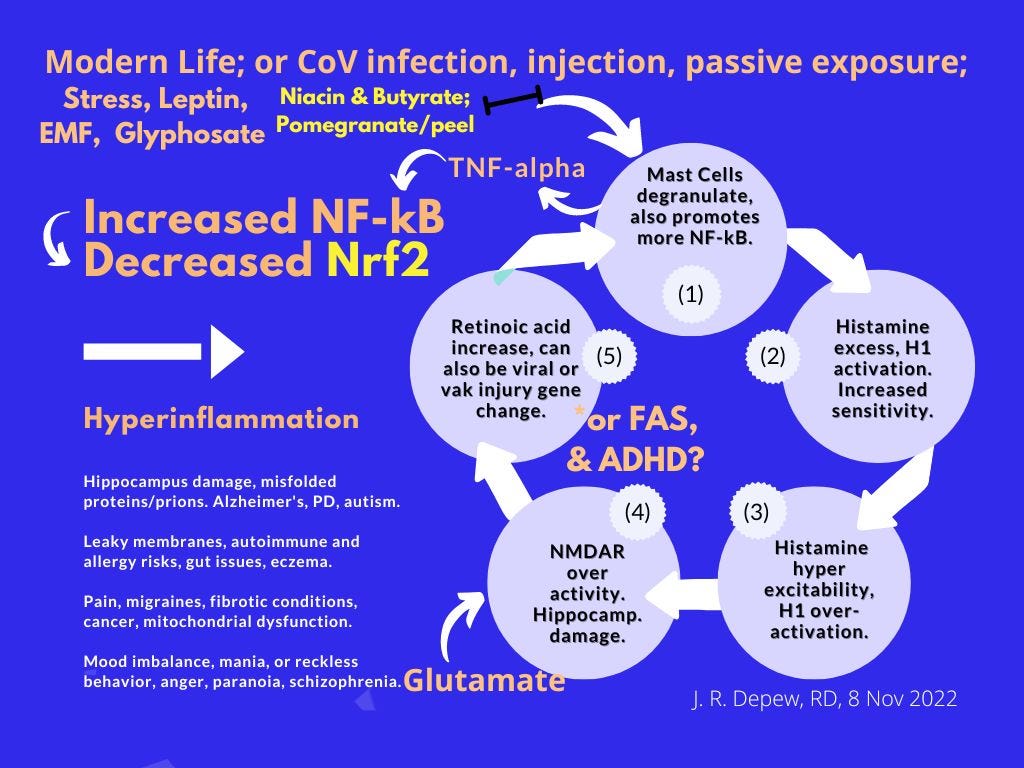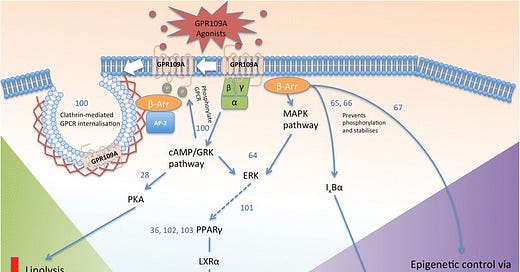The GP109A receptor has a protective role for vascular health, colon health, and really health of the whole body. It helps reduce inflammation in several ways, and not shown in the below graphic, it also can increase endolysosomal engulfment of cellular debris, like infectious viral particles.
Another way the GP109A receptor reduces inflammation is by uncoupling mitochondria from ATP production, instead heat is released similar to what happens in brown fat in cold weather. An article was shared in the comments that is not free fulltext about uncoupling. (Klaus, Ost, 2020) I will look for others.
The quoted article isn’t quite what I was looking for, but its background info mentions that the GP109a receptor is only responsive to niacin in high concentrations, otherwise it is the butyrate receptor (Geisler, et al., 2021) and helps protect our colon if we are eating resistant starch, fiber foods, and adequate zinc to support butyrate producing species. So that is why it is a “high dose niacin” protocol - it has to be to achieve the GP109a results. I wonder what taking butyrate would do for inflammation. Likely it would help somewhat but wouldn’t do everything else that niacin does with NAD+. So, maybe what Dmitry is getting at is that it takes 250 mg of niacin to utilize the GP109a receptor. I do not know.
“The mitochondrial uncoupling protein 2 (UCP2) is essential for NAD+ regeneration during fasting to support high rates of lipid oxidation and ketone production [18,19].” (Geisler, et al., 2021)
I did start the high dose niacin protocol with a 250 mg tablet and the niacin flush with that dose was worse than larger doses after that. Starting gradually is important in my opinion in order to give the body a chance to clear inflammation and cellular debris at what ever slow pace it needs. When I am healthier there is hardly any niacin flush compared to when I am a little more inflamed/allergy-ish. I took about four months to move up from 250 mg once a day to 1000 mg once a day and then I bumped to that twice a day which was a little rapid fro serotonin stability and I backed down for a week or two.
Niacin in high dose effects serotonin levels which may be something I do need, but you need it to be a steady level - so gradual increase and gradual withdrawal from high dose niacin is really important. Melatonin 15 minutes prior to the niacin also seems to help reduce the flush effect. Dmitry is quite brilliant in my opinion, though not 100% correct, still it is worth trying to understand what he is getting at. Niacin research has been suppressed - schizophrenia patients are still not being helped based on the 1970s research and clinical care showing ~ 3000 mg niacin/day works for them. **More on niacin and serotonin after the graphics - an old Twitter Thread by Dmitry, circa 2020.
This is my main post for How-To’s regarding the niacin protocol and cautions about serotonin and gout/acidity: Niacin, & early treatment in general for SARS-CoV-2 is sensible, reduces hospitalization and mortality rate. Jan 22, 2021, (Substack).

Related graphic - at the top we see Niacin & Butyrate; Pomegranate/peel inhibiting the hyperinflammation by preventing mast cell degranulation and inhibiting the NF-kB pathway which otherwise would lead to the hyperinflammation issues listed in the lower left corner of the graphic. The take home point - niacin and a healthy gut that produces butyrate from adequate resistant starch in the diet helps protect us from emotional or physical stress. Pomegranate/peel and many other healthy foods or essential oils, or phytonutrient supplements can also help reduce inflammation.

Twitter Thread by Dmitry Kats, PhD that I copied in my notes instead of just linking to like other Threads that got banned. Roughly - if you were low in serotonin most of your life and start high dose niacin, it will be restoring your serotonin levels to normal - but then you do need to keep a steady intake of niacin to keep the serotonin level at that restored/better level. I really was and am still amazed at how helpful the high dose niacin protocol was for me. People vary, others may not feel the same benefits that I do.
******Thread about serotonin increase temporarily as niacin levels are restored by Dmitry Kats:
“By flushing out the same inflammation that leads to depletion of the tryptophan pathway (which adjacently leads to depletion of serotonin) by all tryptophan depleting down to NAD+ in response to inflammation, niacin will quickly restore serotonin by restoring tryptophan.
It’s not really “excess” serotonin produced but rather, previously depleting/deficient serotonin becoming rapidly restored once the inflammation that was depleting it is flushed out by niacin.
Once inflammation is for the most part flushed out and thermodynamic energy transfer / metabolism / all auxiliary biochemistry are restored to more homeostatic states, supplemented niacin won’t affect tryptophan down to NAD+ or tryptophan to serotonin pathways.
Instead, with continued dosing, sufficiently supplied niacin will then work as continued pump-action against any downstream inflammation / free radical electrons that manifest thereafter by turning into NAADP if needed... and any free intracellular niacin will be urinated out
Does that make sense? Lol
And note: I have come across a few individuals who experience this rapid-restoration of serotonin (and other neurotransmitters) that they’ve never felt before - this marked relative difference in how little serotonin they had now being restored fully at such a rapid pace
Often this is mistakenly confused with an allergic reaction (it's not) or that these individuals can't handle niacin, thinking it's leading to this massive serotonin overload. In reality, it's just the experience of this relative marked difference between how little serotonin...
... they had as a result of it depleting b/c of ensuing inflammation versus its rapid restoration with sufficient niacin supply. Smaller doses can ease this sudden change (but you still want to make sure it's sufficient niacin to induce flush)..
... and very quickly with subsequent continued dosing, the serotonin won't need to restore (and certainly won't need to as rapidly as with the first flush), so those unwanted sensations of rapid serotonin restoration won't occur anymore as serotonin will be restored.
And as noted, continue niacin dosing beyond the doses that flushed out most of this inflammation that was ensuing before niacin dosing, by shielding against further inflammation, will prevent depletion of serotonin (& keep it sufficient) among other compounds/biochemical pathways
My reply about serotonin excess symptoms: Agitation or restlessness, Confusion, Rapid heart rate and high blood pressure, Dilated pupils, Loss of muscle coordination or twitching muscles, Muscle rigidity, Heavy sweating, Diarrhea, Headache, Shivering, Goose bumps - symptoms of increase in serotonin. https://www.mayoclinic.org/diseases-conditions/serotonin-syndrome/symptoms-causes/syc-20354758” - Dmitry Kats, PhD
Summary of research regarding nutrients, micro and macro, that help the immune system fight CoV - B vitamins are needed:
“7.3. Immune System SARS-CoV-2 & Nutrition
The immune system responds to the SARS-CoV-2 via a cytokine storm and hyper inflammation, which itself leads to further multi-organ damage and, in the worst scenario, to death [121]. Yet, it is a fact that people consuming a well-balanced diet are healthier, with a strong immune system, and present a reduced risk of chronic illness, infectious diseases [121]. Furthermore, the immune system is always active, which is accompanied by an increased metabolism rate, requiring energy sources, substrates for biosynthesis, and regulatory molecules. These energy sources, substrates, and regulatory molecules are ultimately derived from the diet. Hence an adequate supply of a wide range of nutrients is essential to support the immune system to function optimally [122].
In this line, the bibliography suggests that vitamins from group B are essential in viral and bacterial infections [123]. Vitamin C is considered as a protective from flu-like symptomatology [124]. Vitamins E and D among zinc have been found essential for the immune system and are especially being studied in the COVID-19 [112]. High protein consumption (>15%) may be a top priority since it induces immunoglobulin production and potential antiviral activity [125]. Furthermore, recent studies suggest that in a regular meal, individuals should eat fruit, vegetables, legumes, nuts, whole grains, unsaturated fats, white meats, and fish. Fruit juice, tea, and coffee can also be consumed cautiously since, sweetened fruit juices, fruit juice concentrates, syrups, fizzy drinks, and still drinks must be avoided [126]. Saturated fat, red meat, more than 5 g salt per day, and industry processed food should be avoided [127].”
Disclaimer: This information is provided for educational purposes within the guidelines of fair use. While I am a Registered Dietitian this information is not intended to provide individual health guidance. Please see a health professional for individual health care purposes.
Reference List
(Chai, Digby, Choudhury, 2013) Chai JT, Digby JE, Choudhury RP. GPR109A and vascular inflammation. Curr Atheroscler Rep. 2013 May;15(5):325. doi: 10.1007/s11883-013-0325-9. PMID: 23526298; PMCID: PMC3631117. https://www.ncbi.nlm.nih.gov/pmc/articles/PMC3631117/ Figure 1: https://www.ncbi.nlm.nih.gov/pmc/articles/PMC3631117/figure/Fig1/
(Geisler, et al., 2021) Geisler CE, Miller KE, Ghimire S, Renquist BJ. The Role of GPR109a Signaling in Niacin Induced Effects on Fed and Fasted Hepatic Metabolism. Int J Mol Sci. 2021 Apr 13;22(8):4001. doi: 10.3390/ijms22084001. PMID: 33924461; PMCID: PMC8069761. https://www.ncbi.nlm.nih.gov/pmc/articles/PMC8069761/
18. Pecqueur C., Bui T., Gelly C., Hauchard J., Barbot C., Bouillaud F., Ricquier D., Miroux B., Thompson C.B. Uncoupling protein-2 controls proliferation by promoting fatty acid oxidation and limiting glycolysis-derived pyruvate utilization. FASEB J. 2007;22:9–18. doi: 10.1096/fj.07-8945com. [PubMed] [CrossRef] [Google Scholar]
19. Sheets A.R., Fülöp P., Derdák Z., Kassai A., Sabo E., Mark N.M., Paragh G., Wands J.R., Baffy G. Uncoupling protein-2 modulates the lipid metabolic response to fasting in mice. Am. J. Physiol. Liver Physiol. 2008;294:G1017–G1024. doi: 10.1152/ajpgi.00016.2008. [PMC free article] [PubMed] [CrossRef] [Google Scholar]
(Klaus, Ost, 2020) Susanne Klaus, Mario Ost, Mitochondrial uncoupling and longevity – A role for mitokines?, Experimental Gerontology, Vol 130, 2020, 110796, ISSN 0531-5565, https://doi.org/10.1016/j.exger.2019.110796. https://www.sciencedirect.com/science/article/pii/S0531556519306722





Does Pomegaranete juice have any of these benefits?